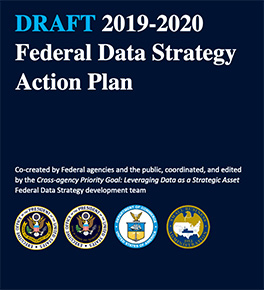
Effective Implementation of the Federal Data Strategy Action Plan

Today, the Data Coalition and the Office of Management and Budget (OMB) co-sponsored a public forum on the Federal Data Strategy’s draft 2019-2020 Action Plan. The event provided an opportunity for industry, academic, and non-profit speakers to provide comments on 16 draft action items in the Federal Data Strategy.
OMB and the leaders of the Data Strategy CAP Goal have introduced data as a critically important element to the President’s Management Agenda. While past PMAs have been issued alongside data-focused initiatives, this is the first PMA to make data a foundational element, complementing IT modernization and workforce improvement as key pillars that support a broad range of additional agency and cross-agency goals. Also significant are the depth and range of issues included in the data strategy itself, and the focus on strong privacy and confidentiality protections throughout the strategy.
As one of the commenters at the Public Forum, below are my written remarks provided about the strategy. These remarks focus on opportunities to drive effective implementation across the strategy and for a number of the individual action plans, based largely on lessons from our research and engagement with government leaders. These opportunities focused on three areas:
1) Operationalizing the strategy and actions
2) Collaborating across governments and sectors to amplify the impact of the strategy
3) Enabling the strategy to ensure that data use evolves with the pace of technological change
Today’s post will discuss “operationalizing the strategy and actions”; tomorrow, another post will cover the collaborating and enabling topics.
Several observations might help OMB and agencies make these actions more operational.
- Action 1, “Create an OMB Data Council” will drive an effective cross-agency leadership framework, and Action 12, “Constitute a Diverse Data Governance Body” will catalyze activity within the agencies led by chief data officers (CDOs).To strengthen this governance approach, linking the agency and cross- agency entities will help amplify top priorities while also opening a bottoms-up channel for cross-agency communication and sharing.The Center’s recent report on Driving Data-Driven Government: The Role of Chief Data Officers, authored by panelist Jane Wiseman, provides models for effective governance from successful state and Federal CDOs, as well as effective approaches to CDO structure, role, and strategies.
- Actions 15, “Identify Data Needs to Answer Key Agency Questions” and 16, “Identify Priority Datasets for Agency Open Data Plans,” include the need to collect input from key stakeholders and align actions with budget and program planning.This ties objectives to resources and builds demands from program leaders that will integrate the strategy into ongoing mission-critical operations, rather than leaving it as a separate strategy without sufficient buy-in or funding. Also, Action 15 speaks to the role of Learning Agendas as a way to strengthen agency capacity; our Center just announced a new report on this topic, and we look forward to sharing the results.
- Another operational element involves making data and insight more accessible to non-experts for decision making. An earlier IBM Center report, The Use of Data Visualization in Government, provides a practical overview of how visualizations can make data digestible to policymakers and the public. The report offers case examples, resources, and recommendations on getting started for agency leaders. Similarly, our four-part series From Data to Decisions, done in collaboration with the Partnership for Public Service, provides examples of leaders who effectively used data to improve operational decisionmaking.
- Operationalizing the strategy would be facilitated through three additional steps:
- Implementing Action 9, “Improve Data Resources for AI Research and Development,” (and Action 16 on priority data sets) focus on both structured and unstructured data, and on ensuring that data reflects the diversity of the US population -- both of which are key to improving the process of training for AI data to mitigate bias.
- Developing data licensing agreements based on global, consensus-based, industry-led standards, such as Community Data License Agreements that focus data sharing and clarity in data usage.
- In action 16, adding a criterion to prioritize “low latency data.” Current decision-support technologies require real-time data feeds for real-time decision making. Low latency data – or data with minimal delay in dissemination – can leverage information to enable real-time use cases such as weather or financial forecasting.
- A final thought on operationalizing the strategy – its depth may also limit the capacity of agencies and stakeholders to take practical steps forward.The 10 principles are arrayed in three topics of stewardship, quality, and continuous improvement; the 40 practices are arrayed by culture, governance, and use; and the 16 actions are arrayed by shared, community, and agency actions.Additionally, the Data Strategy website displays four overlapping areas for exploration:governance; access and use; decisionmaking and accountability; and commercialization and public innovation.To broaden understanding and support, an integrating framework across these elements would be helpful.
My next blog will offer my thoughts on Collaborating across governments and sectors to amplify the impact of the strategy, and Enabling the strategy to ensure that data use evolves with the pace of technological change.



